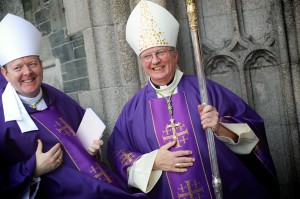
By Sarah Mac Donald - 18 March, 2016

Pic: Stephen Latimer.
When Church and State are too closely aligned, people of faith can lose their prophetic voice, the Bishop of Derry has warned.
In his sermon for St Patrick’s Day Mass in St Patrick’s Church, Pennyburn, Derry City, Bishop Donal McKeown said it is at the edges that faith is always at its best and most uncomfortable.
He said the Churches on the island of Ireland – and especially in the North – “have a wonderful opportunity to work together and to speak uncomfortable truths to those in power” though he admitted that they might lose some support and have to pay a price.
“Pope Francis has told us to be a poor Church for poor people. He has called on us to go out to the margins. As we will see in Holy Week next week, that is where Jesus went and where He died.”
The Bishop emphasised that conflicts – whether WWI or the Easter Rising – “are always signs of the failure of human relationships, never a model to be imitated or glorified”.
Speaking on St Patrick’s Day, Dr McKeown said, “St Patrick certainly was not an early nationalist, he didn’t dress like a 19th century catholic bishop nor can he be hijacked as the original Free Presbyterian!” and he added that St Patrick “did not play on differences but knew that faith could build bridges rather than walls”.
Elsewhere in his homily, the Bishop of Derry underlined that the shamrock is there “to be preached, not just drowned!”
Acknowledging the global popularity of St Patrick today, he noted that last year 160 iconic buildings around the world were illuminated in green for St Patrick’s Day – from Rome to Sydney via Las Vegas, China and Malaysia.
But he said St Patrick’s fame has come about thanks, not mainly to slick marketing, but to the waves of Irish emigrants and missionaries who have left their mark around the world in recent centuries.
He added, “St Patrick’s Cathedrals existed in New York, Auckland and Karachi long before Tourism Ireland or green beer cashed in! Today we are invited to reflect on the man Patrick who has contributed so much for 1550 years – and not just to the marketing ploy that has sprung up in the last couple of decades.”
Asking what might St Patrick say to his spiritual descendants today, as his memory and legacy is celebrated, Bishop McKeown said the shamrock is a popular symbol of Patrick’s faith and of Irishness.
“But his teaching about the Trinity was not vague woolly spirituality. It spoke of a Father who created the people in His image and likeness; of a Son who died on the Cross to bridge the gap between the Creator and his creatures; and, of a Spirit who makes His Temple in our bodies. That is good news for then and for now.”
Patrick’s own struggles and sufferings were a testimony to the fact that there is no cheap grace.
The bishop said that Ireland’s patron saint may have tried to supplant the teachings of the Druids – but he did not seek to replace it with a fuzzy form of religiosity that demands little and promises everything.
“Patrick would tell us that the healing of the world will not happen through our own work or the power of magic crystals,” he said and emphasised that the year of mercy reminds us that salvation does not come from within us but through the power of the Risen Christ.
“Ireland needs a lot of healing. It will not come merely through changing political structures or through the production of more wealth. It will come from the healing of hearts and relationships.”
Bishop McKeown also highlighted that Patrick did not distinguish between the local and newcomers like himself. He sought to find common ground with those he met here.
“He did not play on differences but knew that faith could build bridges rather than walls. After all, when we look back at the political struggle in Ireland about 100 years ago, it is good to remember that Edward Carson and the landed gentry were Irish born – while James Connolly came from Scotland and Éamon de Valera was born in New York and with a Spanish father.”
“I think that Patrick would ask people today to acknowledge that the Irish are the people who live on the island of Ireland. Just as there were warring tribes in Patrick’s time, so too we have to live with difference.”
“And people of faith will always see war and conflict as, at best, a terrible failure that gobbles up the most vulnerable. In this year of centenaries he might ask us to look back with forgiveness for conflict situations rather than with pride or arrogance. We can look back on with admiration for people who died, often heroically, but with much less adulation not for those who wanted to kill.”
Our concern has always to be for the comfort of the weak not for our own comfort. Thus today we celebrate hope and not merely nostalgia. We celebrate not just the present moment but the struggles of the past and the birth of a better future.
St Patrick is not just about a green White House and a green Taj Mahal.
Rather St Patrick’s Day celebrates one of the countless saintly heroes of human history who have not wallowed in self-pity or in the shedding of blood, in self-indulgence or in arrogance but in the celebration of divinely given human dignity and abundant forgiveness, the Bishop commented.
“If we want to be children of Patrick, he asks us to be uncomfortably real – and not to be bewitched by a sham-rock or by a sham-anything-else,” he concluded.